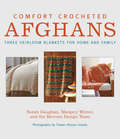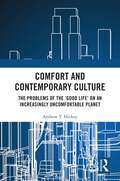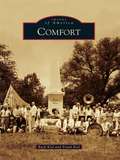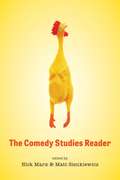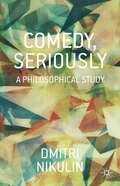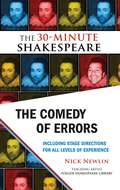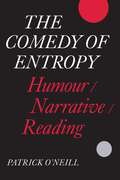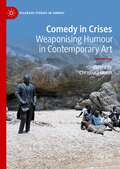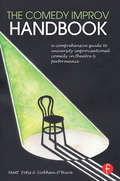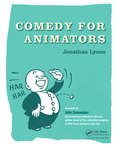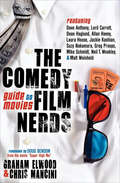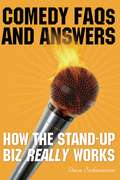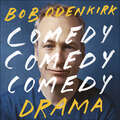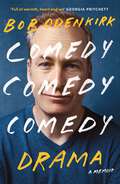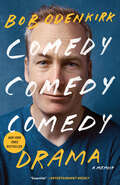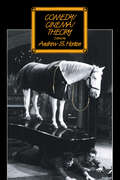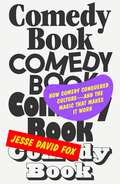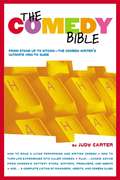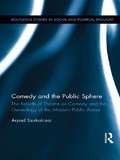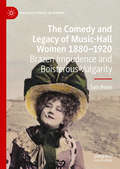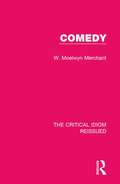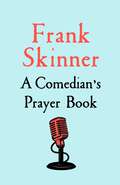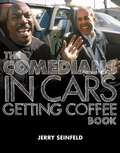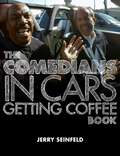- Table View
- List View
Comfort Crocheted Afghans: Three Heirloom Blankets for Home and Family
by Norah Gaughan Margery Winter Berroco Design TeamBrighten your home—or brighten a loved one&’s day—with these clear instructions for creating three cozy, colorful afghans. For many of us, afghans are the epitome of comfort. Colorful and inviting, they are a staple of the home, without which a living room or bedroom just wouldn&’t feel complete. And whether you&’re making one for yourself, as a housewarming gift, or to welcome a new baby into the world, the process of creating a handmade afghan can be as rewarding as the finished product. This sampler from Comfort Knitting & Crochet: Afghans is intended for crocheters of every skill level, and brings new life to the well-loved and versatile afghan.
Comfort Crocheted Afghans: Three Heirloom Blankets for Home and Family
by Norah Gaughan Margery Winter Berroco Design TeamBrighten your home—or brighten a loved one&’s day—with these clear instructions for creating three cozy, colorful afghans. For many of us, afghans are the epitome of comfort. Colorful and inviting, they are a staple of the home, without which a living room or bedroom just wouldn&’t feel complete. And whether you&’re making one for yourself, as a housewarming gift, or to welcome a new baby into the world, the process of creating a handmade afghan can be as rewarding as the finished product. This sampler from Comfort Knitting & Crochet: Afghans is intended for crocheters of every skill level, and brings new life to the well-loved and versatile afghan.
Comfort and Contemporary Culture: The problems of the ‘good life’ on an increasingly uncomfortable planet
by Andrew HickeyTo be comfortable stands as an aspiration of the times; to be comfortable defines what it means to live ‘the good life’. We talk about such things as maintaining a comfortable home, a comfortable lifestyle and a comfortable retirement. We seek out comforts in the relationships we sustain, the leisure practices we enact and the possessions we accumulate. We look for promises of comfort in the words of a close friend and our next pair of shoes. Furnished in the home, optionally outfitted in cars, scrutinised in holiday brochures and brushed up against in the clothes we wear, comfort is there, marking distinctions and framing decisions about what it means to live well. But by consuming comfort in the ways that we do, we do ourselves harm and limit our only planet of its capacity to provide for the requirements of life. This is a world that grows ever more uncomfortable because of comfort and when linked to consumption and excess, indulgence and apathy, it occurs that comfort carries effects that have existential consequence. Utilising analyses of popular culture and ethnographic accounts of everyday life, Comfort and Contemporary Culture works through case study accounts of comfort’s enactment to pose questions around what it means to live, now. Comfort and Contemporary Culture poses alternative renderings of the idea of comfort to return the concept to its earliest roots in notions of confortāre. The revisioning of what we take as comfort requires urgent attention, with the ecological, social and intrapersonal implications of comfort’s current excesses demonstrative of this need. This book will be relevant reading for students and scholars of cultural studies and sociology, cultural anthropology, social geography and studies of community.
Comfort
by Ruth Kiel Frank KielErnst Altgelt and people from what is now Germany founded Comfort in 1854 in the Guadalupe Valley of the Texas Hill Country. When the Civil War began, many of these freethinking people opposed secession. Some attempted to go to Mexico and were surprised by Confederates near the Nueces River. A few Unionists escaped; some were killed, and others were wounded and later killed. In 1865, friends and relatives retrieved their remains, and they now lie under the Treue der Union Monument. The first school was built in 1856, but not until 1892 did Comfort build a church. Charles Apelt created the Armadillo Farm, which made lamps, purses, and baskets from armadillo shells. Today descendants of original settlers live on family ranches and in houses built by their ancestors. Comfort is unincorporated to this day, and it retains a sense of its freethinking independence.
The Comedy Studies Reader
by Nick Marx Matt SienkiewiczFrom classical Hollywood film comedies to sitcoms, recent political satire, and the developing world of online comedy culture, comedy has been a mainstay of the American media landscape for decades. Recognizing that scholars and students need an authoritative collection of comedy studies that gathers both foundational and cutting-edge work, Nick Marx and Matt Sienkiewicz have assembled The Comedy Studies Reader. This anthology brings together classic articles, more recent works, and original essays that consider a variety of themes and approaches for studying comedic media—the carnivalesque, comedy mechanics and absurdity, psychoanalysis, irony, genre, race and ethnicity, gender and sexuality, and nation and globalization. The authors range from iconic theorists, such as Mikhail Bakhtin, Sigmund Freud, and Linda Hutcheon, to the leading senior and emerging scholars of today. As a whole, the volume traces two parallel trends in the evolution of the field—first, comedy’s development into myriad subgenres, formats, and discourses, a tendency that has led many popular commentators to characterize the present as a “comedy zeitgeist”; and second, comedy studies’ new focus on the ways in which comedy increasingly circulates in “serious” discursive realms, including politics, economics, race, gender, and cultural power.
Comedy, Seriously
by Dmitri NikulinComedy, Seriously provides a philosophical interpretation of comedy and argues that comedy displays a particular kind of rationality that reflects philosophical thinking. In particular, that comedy is defined not so much by laughter or jokes, but rather the structure of its plot, which is isomorphic with that of the philosophical argument. Comedy allows for the resolution of a conflict and the achievement of well-being and equality through action that follows the comic plot. Moreover, such action is propelled by the 'thinker on stage, ' who, as socially and politically oppressed, contributes to the liberation of all and the achievement of the good life. Comedy, therefore, establishes the universal pattern for justice and well-being and allows us to rethink the notion of subjectivity not as the modern isolated subject, but rather as integrated with others through shared action and dialogical involvement.
The Comedy of Errors: The 30-Minute Shakespeare
by Nick NewlinThe Comedy of Errors: The 30-Minute Shakespeare offers five raucous scenes from this extravaganza of mistaken identity.The abridgement begins with a dramatic physical enactment of the twins' separation at sea. The play continues with a series of foibles featuring Antipholus of Ephesus, Dromio of Ephesus, and their identical twin counterparts from Antipholus.Adriana and Luciana receive hysterically misguided attention from the twins. Emilia and Egeon as the long-lost parents, and the riotous conjurer Dr. Pinch round out the cast of characters in Shakespeare's most uproarious comedy.The edition includes a preface by Nick Newlin containing helpful advice on how to put on a Shakespeare performance in a high school class with novice actors, as well as an appendix with suggestions for the specific play and recommendations for further resources.
The Comedy of Entropy: Humour/Narrative/Reading (The Royal Society of Canada Special Publications)
by Patrick O'NeillEntropic comedy is the phrase coined by Patrick O'Neill in this study to identify a particular mode of twentieth-century narrative that is not generally recognized. He describes it as the narrative expression of forms of decentred humour, or what might more loosely be called 'black humour.'O'Neill begins his investigation by examining the rise of an essentially new form of humour over the last three hundred years or so in the context of a rapid decay of confidence in traditional authoritative value systems. O'Neill analyses the resulting reorganization of the spectrum of humour, and examines th implications of this for the ways in which we read texts and the world we live in.He then turns from intellectual history to narratology and considers the relationship, in theoretical terms, of homour, play, and narrative as systems of discourse and the role of the reader as a textualizing agent.Finally, he considers some dozen twentieth-century narratives in French, German, and English (with occasional reference to other literatures) in the context of those historical and theoretical concerns. Authors of the texts analysed include Céline, Camus, Satre, and Robbe-Grillet in French; Heller, Beckett, Pynchon, Nabokov, and Joyce in English; Grass, Kafka, and Handke in German. The analyses proceed along lines suggested by structuralist, semiotic, and post-structuraist narrative and literary theory. From his analyses of these works O'Neill concludes they illustrate in narrative terms a mode of modern writing definable as entropic comedy, and he develops a taxonomy of the mode.
Comedy in Crises: Weaponising Humour in Contemporary Art (Palgrave Studies in Comedy)
by Chrisoula LionisComedy in Crises provides a novel contribution to an emerging comedy studies field, offering a fresh approach and understanding toward both the motivation and reception of humour in diverse contemporary art contexts. Drawing together research by artists, theorists, curators, and historians from around the world (from Palestine, to Greece, Brazil, and Indigenous Australia), it provides new insight into how humour is weaponised in contemporary art – focusing on its role in negotiating complex cultural identities, the expectations of art markets, the impact of historical legacies, as well as its role in bolstering cultural resilience. In so doing, this book explores a vital, yet under-explored, aspect of contemporary art. Over the last decade, we have witnessed an overwhelming emphasis on experiences of precarity and emergency in contemporary art discourse, reflecting a popular view that the decade following the outbreak of the global financial crisis has been marked by an intersection of constant crises (refugee crisis, sovereign debt crisis, environmental disaster, COVID). Comedy in Crises offers innovative analysis of the relationship between this context and the growing use of humour by artists from around the world, making clear the vital role of laughter in mediating the collective trauma that takes shape today in a period of protracted crisis.
The Comedy Improv Handbook: A Comprehensive Guide to University Improvisational Comedy in Theatre and Performance
by Matt Fotis Siobhan O'HaraThe Comedy Improv Handbook: A Comprehensive Guide to University Improvisational Comedy in Theatre and Performance is a one-stop resource for both improv teachers and students, covering improv history, theory, maxims, exercises, games, and structures. You will learn the necessary skills and techniques needed to become a successful improviser, developing a basic understanding of the history of improvisation and its major influences, structures, and theories. This book also addresses issues associated with being a college improviser – like auditions, rehearsals, performances, and the dynamics of improv groups.
Comedy for Animators
by Jonathan LyonsWhile comedy writers are responsible for creating clever scripts, comedic animators have a much more complicated problem to solve: What makes a physical character funny? Comedy for Animators breaks down the answer by exploring the techniques of those who have used their bodies to make others laugh. Drawing from traditions such as commedia dell'arte, pantomime, Vaudeville, the circus, and silent and modern film, animators will learn not only to create funny characters, but also how to execute gags, create a comic climate, and use environment as a character. Whether you're creating a comic villain or a bumbling sidekick, this is the one and only guide you need to get your audience laughing! Explanation of comedic archetypes and devices will both inspire and inform your creative choices Exploration of various modes of storytelling allows you to give the right context for your story and characters Tips for creating worlds, scenarios, and casts for your characters to flourish in Companion website includes example videos and further resources to expand your skillset--check it out at www.comedyforanimators.com! Jonathan Lyons delivers simple, fun, illustrated lessons that teach readers to apply the principles of history's greatest physical comedians to their animated characters. This isn't stand-up comedy--it's the falling down and jumping around sort!
The Comedy Film Nerds Guide to Movies: Featuring Dave Anthony, Lord Carrett, Dean Haglund, Allan Havey, Laura House, Jackie Kashian, Suzy Nakamura, Greg ... Schmidt, Neil T. Weakley, and Matt Weinhold
by Doug Benson Chris Mancini Mike Schmidt Greg Proops Dave Anthony Graham Elwood Lord Carrett Dean Haglund Allan Havey Laura House Jackie Kashian Suzy Nakamura Neil T. Weakley Matt WeinholdA movie guide for film and comedy fans, by filmmakers and comedians, for the movie lover with a good sense of humor. Tired of the usual boring, dry movie discussion? The Comedy Film Nerds Guide to Movies is something new. Is it serious movie discussion? Is it funny? Do the writers know what the hell they are talking about? Yes, yes, yes, and yes. Okay, that’s too many yes’s, but you get the point. Graham Elwood and Chris Mancini, both professional filmmakers and comedians, created comedyfilmnerds.com to mind meld the idea of real movie talk and real funny. And they called in all of their professionally funny and filmy friends to help them. Comedians and writers who have been on everything from the Tonight Show to their own comedy specials tell you what’s what about their favorite film genres. While The Comedy Film Nerds Guide to Movies is funny and informative, each genre is given a personal touch. All of the Comedy Film Nerds have a love of film and a personal connection to each genre. Read about a love of film from an insider’s perspective. The Comedy Film Nerds Guide to Movies brings what has been missing from movie discussion for too long: a healthy dose of humor.
Comedy FAQs and Answers: How the Stand-up Biz Really Works
by Dave SchwensenThis guide to the world of stand-up comedy, written in easy-to-use Q&A format, provides current and potential comedians with the no-nonsense advice they need for every stage of their careers. Schwensen's lively book features interviews with many of the top names in stand-up-Ray Romano, George Carlin, Christopher Titus, Weird Al Yankovic, Margaret Cho-all sharing lessons learned along the way. Additional interviews with club owners, talent executives, publicists, and others provide behind-the-scenes expertise.
Comedy, Comedy, Comedy, Drama: The Sunday Times bestseller
by Bob OdenkirkIn this brilliantly entertaining and heartfelt memoir, beloved star and comic maverick Bob Odenkirk writes honestly about the highs and lows of showbiz: his work on infamous cult comedy Mr. Show, as a performer and writer on legendary series such as The Larry Sanders Show and Saturday Night Live, becoming everyone's favourite lawyer in global hit TV series' Breaking Bad and Better Call Saul, and what it's like to reinvent himself as an action film ass-kicker at fifty in Nobody. Bob Odenkirk's career is inexplicable. And yet he will try like hell to explicate it for you... Featuring humorous tangents, never-before-seen photos, wild characters, and Bob's trademark unflinching drive and humour, Comedy Comedy Comedy Drama is a classic showbiz tale told by a determined idiot.(P) 2022 Penguin Audio
Comedy, Comedy, Comedy, Drama: A Memoir
by Bob OdenkirkIn this hilarious, heartfelt memoir, the star of Mr. Show and Breaking Bad spin off Better Call Saul opens up about the highs and lows of showbiz, his cult status as a comedy writer, and what it's like to reinvent himself at age fifty as an action-film ass-kicker.Bob Odenkirk's career is inexplicable. And yet he will try like hell to explicate it for you. Charting a "Homeric" decades-long "odyssey" from his origins in the seedy comedy clubs of Chicago to a dramatic career full of award nominations-with a side-trip into the action-man world that is baffling to all who know him-it's almost like there are many Bob Odenkirks! But there is just one, and one is plenty.Bob embraced a life in comedy after a chance meeting with Second City's legendary Del Close, then somehow made his way to a job as a writer at Saturday Night Live. While surviving that legendary gauntlet by the skin of his gnashing teeth, he stashed away the secrets of comedy writing-eventually employing them in the immortal "Motivational Speaker" sketch for Chris Farley, honing them on The Ben Stiller Show, and perfecting them on Mr. Show with Bob and David.In Hollywood, Bob demonstrated a bullheadedness that would shame Sisyphus himself, and when all hope was lost for the umpteenth time, the phone rang with an offer to appear on Breaking Bad-a show about how boring it is to be a high school chemistry teacher. His embrace of this strange new world of dramatic acting led him to working with Steven Spielberg, Alexander Payne, and Greta Gerwig, and then, in a twist that will confound you, he re-re-invented himself as a bona fide action star. Why? Read this and do your own psychoanalysis-it's fun!Featuring humorous tangents, never-before-seen photos, wild characters, and Bob's trademark unflinching drive and humour, Comedy Comedy Comedy Drama is a classic showbiz tale told by a determined idiot.
Comedy Comedy Comedy Drama: A Memoir
by Bob OdenkirkBob Odenkirk’s career is inexplicable. And yet he will try like hell to explicate it for you. Charting a “Homeric” decades-long “odyssey” from his origins in the seedy comedy clubs of Chicago to a dramatic career full of award nominations—with a side-trip into the action-man world that is baffling to all who know him—it’s almost like there are many Bob Odenkirks! But there is just one and one is plenty. <p><p> Bob embraced a life in comedy after a chance meeting with Second City’s legendary Del Close. He somehow made his way to a job as a writer at Saturday Night Live. While surviving that legendary gauntlet by the skin of his gnashing teeth, he stashed away the secrets of comedy writing—eventually employing them in the immortal “Motivational Speaker” sketch for Chris Farley, honing them on The Ben Stiller Show, and perfecting them on Mr. Show with Bob and David. <p><p> In Hollywood, Bob demonstrated a bullheadedness that would shame Sisyphus himself, and when all hope was lost for the umpteenth time, the phone rang with an offer to appear on Breaking Bad—a show about how boring it is to be a high school chemistry teacher. His embrace of this strange new world of dramatic acting led him to working with Steven Spielberg, Alexander Payne, and Greta Gerwig, and then, in a twist that will confound you, he re-re-invented himself as a bona fide action star. Why? Read this and do your own psychoanalysis—it’s fun! <p><p> Featuring humorous tangents, never-before-seen photos, wild characters, and Bob’s trademark unflinching drive, Comedy Comedy Comedy Drama is a classic showbiz tale told by a determined idiot. <p> <b>New York Times Bestseller</b>
Comedy/Cinema/Theory
by Andrew HortonThe nature of comedy has interested many thinkers, from Plato to Freud, but film comedy has not received much theoretical attention in recent years. The essays in Comedy/Cinema/Theory use a range of critical and theoretical approaches to explore this curious and fascinating subject. The result is a stimulating, informative book for anyone interested in film, humor, and the art of bringing the two together.Comedy remains a central human preoccupation, despite the vagaries in form that it has assumed over the centuries in different media. In his introduction, Horton surveys the history of the study of comedy, from Aristophanes to the present, and he also offers a perspective on other related comic forms: printed fiction, comic books, TV sitcoms, jokes and gags.Some essays in the collection focus on general issues concerning comedy and cinema. In lively (and often humorous) prose, such scholars as Lucy Fischer, Noel Carroll, Peter Lehman, and Brian Henderson employ feminist, post-Freudian, neo-Marxist, and Bakhtinian methodologies. The remaining essays bring theoretical considerations to bear on specific works and comic filmmakers. Peter Brunette, William Paul, Scott Bukatman, Dana Polan, Charles Eidsvik, Ruth Perlmutter, Stephen Mamber, and Andrew Horton provide different perspectives for analyzing The Three Stooges, Chaplin, Jerry Lewis, Woody Allen, Dusan Makavejev, and Alfred Hitchcock's sole comedy, Mr. and Mrs. Smith, as well as the peculiar genre of cynical humor from Eastern Europe.As editor Horton notes, an over-arching theory of film comedy does not emanate from these essays. Yet the diversity and originality of the contributions reflect vital and growing interest in the subject, and both students of film and general moviegoers will relish the results.
Comedy Book: How Comedy Conquered Culture–and the Magic That Makes It Work
by Jesse David FoxOne of NPR's Best Books of 2023. Named a Most Anticipated Book by Vulture, Elle, Chicago Tribune, The Millions, and Lit Hub."Comedy Book changes the way we talk about an art form that is more diverse and exciting than ever before.” —Seth Meyers "Energetic and wise . . . Comedy Book is not the definitive history of the past three-plus decades. It’s Fox’s history, and better for it." —The New York Times Book ReviewFrom a beloved comedy critic, a wisecracking, heartfelt, and overdue chronicle of comedy’s boom—and its magic.Comedy is king. From multimillion-dollar TV specials to sold-out stand-up shows and TikTok stardom, comedy has never been more popular, democratized, or influential. Comedians have become organizing forces across culture—as trusted as politicians and as fawned-over as celebrities—yet comedy as an art form has gone under-considered throughout its history, even as it has ascended as a cultural force.In Comedy Book, Jesse David Fox—the country’s most definitive voice in comedy criticism and someone who, in his own words, “enjoys comedy maybe more than anyone on this planet"—tackles everything you need to know about comedy. Weaving together history and analysis, Fox unravels the genre’s political legacy through an ode to Jon Stewart, interrogates the divide between highbrow and lowbrow via Adam Sandler, and unpacks how marginalized comics create spaces for their communities. Along the way, Fox covers everything from comedy in the age of political correctness and Will Smith’s slap to the right wing’s relationship with comedy and, for Fox, comedy’s ability to heal personal tragedy.With memorable cameos from Jerry Seinfeld, Dave Chappelle, John Mulaney, Ali Wong, Kate Berlant, and countless others, Comedy Book is an eye-opening education in how to engage with our most omnipresent art form, a riotous history of American pop culture, and a love letter to laughter.
The Comedy Bible: From Stand-up to Sitcom--the Comedy Writer's Ultimate "How To" Guide
by Judy CarterDo you think you're funny? Do you want to turn your sense of humor into a career? If the answer is yes, then Judy Carter's The Comedy Bible is for you. The guru to aspiring stand-up comics provides the complete scoop on being -- and writing -- funny for money. If you've got a sense of humor, you can learn to make a career out of comedy, says Judy Carter. Whether it's creating a killer stand-up act, writing a spec sitcom, or providing jokes for radio or one-liners for greeting cards, Carter provides step-by-step instructions in The Comedy Bible. She helps readers first determine which genre of comedy writing or performing suits them best and then directs them in developing, refining, and selling their work. Using the hands-on workbook format that was so effective in her bestselling first book, Stand-Up Comedy: The Book, Carter offers a series of day-by-day exercises that draw on her many years as a successful stand-up comic and the head of a nationally known comedy school. Also included are practical tips and advice from today's top comedy professionals -- from Bernie Brillstein to Christopher Titus to Richard Lewis. She presents the pros and cons of the various comedy fields -- stand-up, script, speech and joke writing, one-person shows, humor essays -- and shows how to tailor your material for each. She teaches how to find your "authentic" voice -- the true source of comedy. And, perhaps most important, Carter explains how to take a finished product to the next level -- making money -- by pitching it to a buyer and negotiating a contract. Written in Carter's unique, take-no-prisoners voice, The Comedy Bible is practical, inspirational, and funny.
Comedy and the Public Sphere: The Rebirth of Theatre as Comedy and the Genealogy of the Modern Public Arena (Routledge Studies in Social and Political Thought #77)
by Arpad SzakolczaiThe book aims at reframing the discussion on the "public sphere," usually understood as the place where the public opinion is formed, through rational discussion. The aim of this book is to give an account of this rationality, and its serious shortcomings, examining the role of the media and the confusing of public roles and personal identity. It focuses in particular on the role of the theatrical and comical in the historical development of the public sphere, and in this manner reformulating definitions of common sense, personal identity, and culture.
The Comedy and Legacy of Music-Hall Women 1880-1920: Brazen Impudence and Boisterous Vulgarity (Palgrave Studies in Comedy)
by Sam BealeThis book explores the comedy and legacy of women working as performers on the music-hall stage from 1880–1920, and examines the significance of their previously overlooked contributions to British comic traditions. Focusing on the under-researched female ‘serio-comic’, the study includes six micro-histories detailing the acts of Ada Lundberg, Bessie Bellwood, Maidie Scott, Vesta Victoria, Marie Lloyd and Nellie Wallace. Uniquely for women in the late-nineteenth and early-twentieth centuries, these pioneering performers had public voices. The extent to which their comedy challenged Victorian and Edwardian perceptions of women is revealed through explorations of how they connected with popular audiences while also avoiding censorship. Their use of techniques such as comic irony and stereotyping, self-deprecation, and comic innuendo are considered alongside the work of contemporary stand-up comedians and performance artists including Bridget Christie, Bryony Kimmings, Sara Pascoe, Shazia Mirza and Sarah Silverman.
Comedy (The Critical Idiom Reissued #20)
by Moelwyn MerchantFirst published in 1972, this work pursues the question ‘what is comedy?’ In its quest for an answer it explores critical theory, psychology, sociology and metaphysics. It also examines the classical origins of comedy, different kinds of comedy, the rituals of comedy, its relationship with other idioms such as ‘satire’, irony’ and ‘farce’, and compares two major traditions: ‘Aristophanic’ and ‘Shakesperean’ comedy. In doing so, the book demonstrates the indefinable and flexible nature of comedy. This work will be a valuable resource to those studying drama, and in particular, those focusing on classical and Shakespearean plays.
A Comedian's Prayer Book
by Frank SkinnerA Comedian's Prayer Book. The title is a worry, isn't it?...God is a tough audience as far as audible response is concerned, but at least you don't have to explain the references. In this collection of prayers, much-loved comedian, broadcaster and radio host Frank Skinner has tried to retain the bare candour of the rehearsal-room improvisation - to show what faith feels like, from the inside - but infused it with all the production values required to make it a passable public entertainment. In it are his convictions, his questions, his fears, his doubts, his elations - all presented in an eavesdropper-friendly form. Hell, Judgement, atheism, money, faith and the X-Men all feature: it's a bit like reading the Bible, except you only get one side of the conversation, and all the jokes are left in.
The Comedians in Cars Getting Coffee Book
by Jerry SeinfeldA celebration of and behind-the-scenes look at Jerry Seinfeld’s groundbreaking streaming series Comedians in Cars Getting Coffee. <p><p>In his streaming show, Comedians in Cars Getting Coffee, Jerry Seinfeld has engaged with some of the funniest people in history in classic cars, coffee shops, and diners. He has reminisced with Larry David; bantered with legends Steve Martin, Tina Fey, and Eddie Murphy; reunited with the cast of Seinfeld; and even paid a visit to President Barack Obama in the Oval Office. These and dozens of other guests talked about the intricacies of stand-up, the evolution of their careers and personal lives, and whatever else popped into their brilliant minds. <p><p>Seinfeld’s carefully crafted episodes have reimagined the talk show format, each one a unique, hilarious, and yet intimate conversation—a rare opportunity for viewers to witness their favorite performers unscripted and unvarnished. But in producing eighty-four episodes over eleven seasons, he has also created arguably the most important historical archive about the art of comedy ever amassed, with episodes featuring Garry Shandling, Jerry Lewis, Don Rickles, Carl Reiner, and Norm McDonald already serving as permanent shrines for legendary comedians. Timed to the 10th anniversary of the show’s debut and with an introduction from Jerry Seinfeld, this book isn’t just a record of the show but instead an inventive tribute full of behind-the-scenes photos and anecdotes. The book dives into the inspiration and creation of segments, the most unforgettable lines from guests, an index of the cars, and some of the most memorable moments from crew members. Originally conceived as an “anti-talk show,” Comedians in Cars Getting Coffee earned multiple Emmy nominations and helped lead the streaming revolution. <p> <b>New York Times Bestseller</b>
The Comedians in Cars Getting Coffee Book
by Jerry SeinfeldA celebration of and behind-the-scenes look at Jerry Seinfeld&’s groundbreaking streaming series Comedians in Cars Getting Coffee.Over eleven seasons and eighty-four episodes, Jerry Seinfeld drove around in classic cars, grabbing coffee and chatting with the funniest people alive. He reminisced with the late Garry Shandling; bantered with legends Steve Martin, Tina Fey, and Eddie Murphy; reunited with the cast of Seinfeld; and even paid a visit to President Barack Obama in the Oval Office. These and dozens of other guests talked about the intricacies of stand-up, the evolution of their careers and personal lives, and whatever else popped into their brilliant minds. The result was not only a hilarious collection of casual yet intimate conversations—a rare opportunity for viewers to witness their favorite performers unscripted and unvarnished—but arguably the most important historical archive about the art of comedy ever amassed.Now that archive is preserved in the form of a gorgeously designed and carefully curated book. Seinfeld has hand-picked the show&’s keenest insights and funniest exchanges. Also included is a fascinating oral history featuring interviews with dozens of crew members, executives, guests, and Seinfeld himself that details how this scrappy creative experiment landed unprecedented access to the White House, earned multiple Emmy nominations, and helped lead the streaming revolution.Featuring a newly written introduction by Seinfeld and filled with beautiful never-before-seen production photos, this book is essential reading for comedy lovers, car aficionados, coffee connoisseurs, and Jerry Seinfeld fans.
